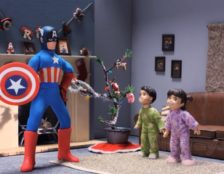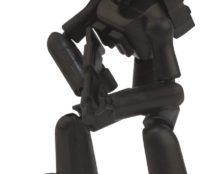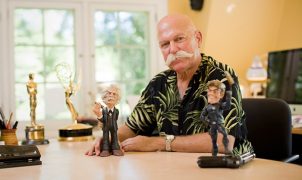I came across this wonderful behind the scenes video recently from Chris Sullivan. In it he details how he created the paper cutout stop motion puppets he used in his 2012 stop motion movie “Consuming Spirits”
I would encourage all those new to paper cutout animation to read through and watch his description of his art at work. Chris begins…
Hello, this is Chris Sullivan. I am going to make a little video here to show you how to make these puppets that I use in my film Consuming Spirits. This is a method that I found works really well and these puppets last for thousands and thousands of movements, years even.

So this is a box of puppets from Consuming Spirits many, many, puppets. This is a big wagon, this is a hand, here is an arm, now I am going to show you how to make these paper arms and bodies. Many little things here, here is a full size character he has those slots for his jaw, he lost an arm. Here is mother Superior, she has replacement jaws which are not seen here. Here is Victor, with an eye missing. This is a front face, these little jaws parts here are done with little pockets, that I make a slit and then I slide in and here is the back of one of the puppets. Here is Earl Grey with his mouth open and here is the back of his puppet. I’m going to show you how to make these paper joints here that you see in these puppets. This is how big they can be, and here is how little they can be. So these little ones are difficult.


This is a character that I designed, so now I am going to make his body parts but I have to make sure that they overlap. So you will see what that means in just a minute. So the hand will be here, make it go that far in. So I have to make sure that I am covering the stretch of all the different parts, and the same with this other hand here. This character is typing, is what I was thinking here. So I don’t get lost, I sometimes will do this RR – LL. So then the body, the body I am going to cover the whole expansive character. Neck, head, what you finally end up getting in the end is something that looks like this.

The finer details with glue..
Ok so now I’ve got this guy, and I’ve colored him very simply here, sloppy with some water colored pencils. It’s important to color things before you cut them out, because you don’t want to be… You don’t want them to bend around. So now what I am going to do is I am going to take out a section here. Now I am cutting it out kind of losely for two reasons, one is I don’t want to bend the paper when I am cutting, but the other reason is I am actually going to put punches in this guy. So I am going to put a punch, so I am going to put the punch back here. Alright, actually I’ve got a slotted hand here. So now that I’ve got that I am going to cut this guy out. I’m just using scissors but if you want to use exacto blade, whatever works for you. I kind of like scissors, but I do both depending on the object.

Using Bristle board..
If you are doing these cut outs with sound cut outs, you can use just paper but it’s sometimes nice if you can to mount them on paper. I am using Bristle board by the way, which is really great because it has no tooth. And tooth is kind of cool, but if you are going to do close ups you sometimes don’t want people to see the paper, depends on what your aesthetic is. So now I am going to make the camera a little more close up when I finish this. Now I’ve cut this guy out and I will show you a few different hinges that I have made. So this is a piece of paper… This has a hole punched in it just like this does and there is a tiny bit of glue that connects this with this. Ok, so I am going to make that kind of hand… Just kind of change it up and show you how to make cause it’s pretty obvious. This is just glued from here and here and these little edges and this hand is just sliding in like a little pocket. This is nice you can have a lot of movement and there is a nice little resistance in these puppets so it’s easy to move them.

Finishing the Joint..
So now I am going to place this here and have all my little elements sticking on here waiting. This is my presser to press the glue that is rounded with the sharpie here. And I have a little thing of Elmer’s. Elmer’s glue is what I use. This looks like it might be wood glue, but it’s still Elmer’s wood glue so I just use Elmer’s. Now the trick here is that you have to… And I have a little exacto blade to pick this up like this. You have to use a very small amount of glue, and this is the only thing that adults sometimes can’t do and kids can. I am just going to use a tiny little dot and now I going to close up to do the rest of this. You have to go a little bit fast here, so that these things do…. Tiny little tiny drop, put that there, take this here, and I am firmly pressing down and holding for about maybe ten seconds. If you put too much glue you won’t be able to rotate it, hopefully we put the right amount, take that, the first thing that we do is see if it moves, which it does. So this should move along with this, this stays still. And there you have this little puppet and he works very nice.

When Animating..
When I actually animate with them, I actually use a needle or the tip of an exacto blade to move them around. And that’s how I keep them from getting greasy or dirty. There you go. And one thing, I didn’t black the whole puppet but I blacked this one hand, and I do do this to all my puppets this is just not something like sharpie but water souliable black, and that is so that it doesn’t reflect when you do multiple plane. It doesn’t reflect the white of the puppet. This same construction works great for silhouette puppets too. If you want to use thicker materials, it can be cool too. It’s just, you have to just accept the texture of them. I did one other thing here, I blacked the edge of the figure. I probably shouldn’t of blacked this elbow, because it made it not continuous. One thing to realize too is, I make my puppets three quarter, cause three quarters is really cinematically the most common shot that you want to use. So I make two, three quarter puppets, a full frontal you hardly ever use, cause it looks too subjective, side puppets are kind of cool sometimes but they have limits too. So three quarter if you watch a film, 90 percent of your shots, your actors, are in three quarter, same with animation. Ok, I hope that is helpful, thank you.
Please support Chris over at his site linked here



















